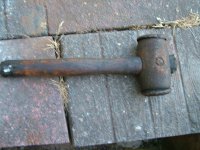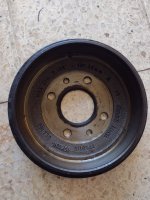I have seen people rip the threads out of the drum doing that so be careful.Hi,
I am currently trying to take off the rear drum but is stuck. According to the Haynes manual "if the drum is binding on the brake shoes screw two M10 bolts into the locating stud threaded holes in the drum, and progressively tighten them against the hub flange to push the drum from the hub"
I've tried to do this without any luck but I guess it depends on the position of the hub as there are different parts of the rear brake that you could be pushing on. I have tried the 'ten to four' and the 'quarter to three' positions...any trips greatly appreciated !
Thanks again
What I tend to do is spray a little oil around the hub to drum flange area, then I use a large copper mallet "gently" to break it free from the hub against the area the wheel contacts , it tends to spring off then. A normal steel hammer is more likely to cause damage.
The time I have found the bolts and thread method of use is where the brake drum is badly worn and the brake shoes are catching on the wear ridge in the drum and it can help with "see sawing" the drum off. Though I thought it was M8s with a 13mm spanner or socket to extract via the wheel locating studs.
Re the brake servo working when pedal drops on starting the engine, it does sound like it is doing something, though how much is the critical factor. Usually if servo good you can go back to the car 30 minutes or more later and still feel the servo is working holding the vacuum before starting the engine, that would indicate no leaks.
When drums off, if no leaks visible and shoes in good order, I often use two screwdrivers to move the brake shoes forward and back as a guide to any seized brake cylinders, as that can give a firm brake pedal with poor stopping ability. I also flip the dust covers back to see any early signs of brake cylinders starting to leak.
Front brake calipers can seize also, although you are more likely to have noticed pulling to one side if that was the case.




